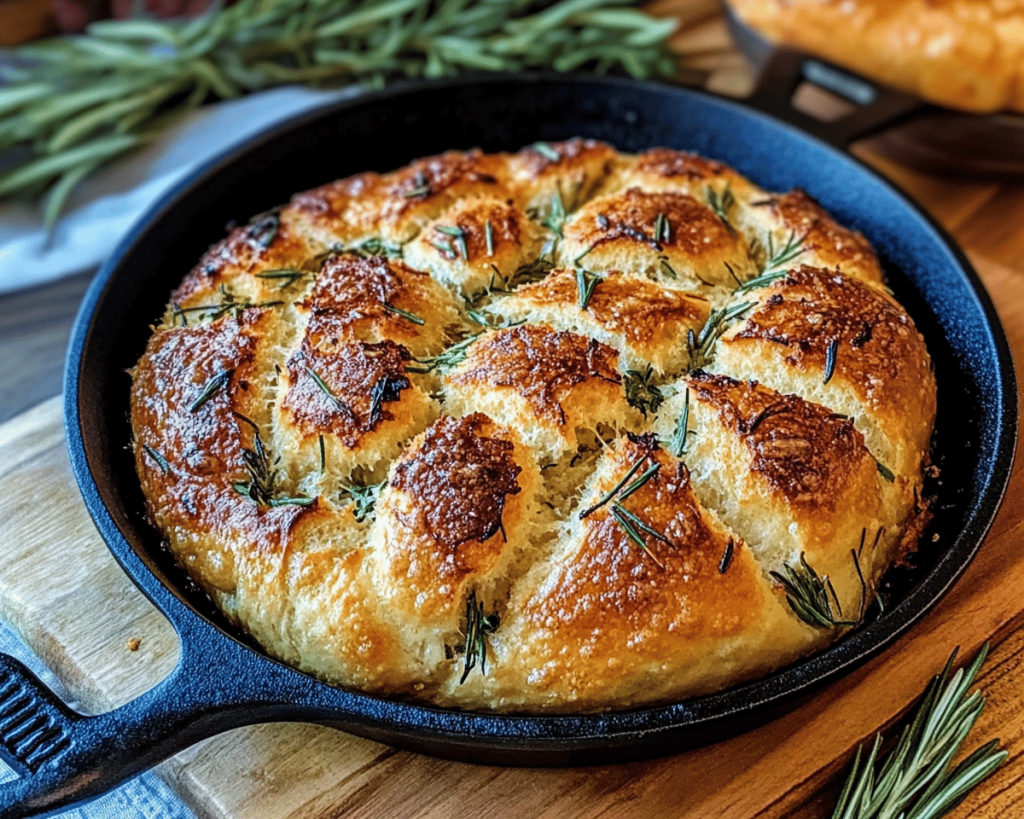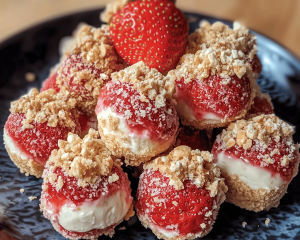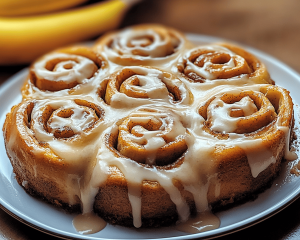Every kitchen has its own signature scent, a fragrance that lingers in the air long after the meal has been savored. For me, that aroma is the warm, inviting essence of **Rustic Garlic Rosemary Skillet Bread**. A simple loaf, yes, but one that wraps you in its comforts, drawing on memories of family gatherings, friendly dinners, and quiet moments spent with a book in one hand and a warm slice in the other. This bread became a staple in my home not just for its delicious taste but also for the connections it nurtured and the lessons it taught me.
I first stumbled upon this recipe during a particularly chilly autumn. The leaves had begun to turn, creating a magnificent tapestry of reds and golds outside my kitchen window. I had a small gathering planned for a few friends, a cozy evening fueled by stories and laughter. I wanted bread that would not only accompany our meal but elevate it, a warm embrace for the heart and an invitation for the palate. In flipping through a well-loved cookbook, This rustic skillet bread knocked—no, barged—in with all its earthy charm, and I knew it was destined to become a cherished part of my culinary repertoire.
There is something incredibly grounding about making bread; kneading the dough allows one to channel energy, thoughts, and even frustrations into the mixture. The rhythmic poking and pulsing of the dough was meditative. When I first baked it, I learned that bread-making requires patience but rewards you in kind: the gentle bubbling of yeast, the aroma of simmering garlic wafting through the air, and the moment of truth as you pull the loaf from the skillet—a golden crust encasing a soft, fragrant interior.
What sets this bread apart is its rustic simplicity, enhanced by robust flavors. Garlic, a staple in my kitchen, pairs flawlessly with fresh rosemary, ultimately breathing life into the dough. As you slice it, the visual splendor and the smell alone evoke the comfort of being wrapped in a warm sweater on a cool night. It’s more than just food; it’s a tribute to the beauty of togetherness, the joy of savoring moments crafted through shared experiences. I can still see a close friend’s eyes light up as they took that first bite, grinning at the richness of flavor. It ignites memories of laughter echoing in my kitchen, conversations flowing like the soft olive oil we dipped the bread into, and the warmth of companionship.
Let’s delve into the ingredients that make this rustic bread a beloved favorite in my home, shall we?
Inside the Ingredients of Rustic Garlic Rosemary Skillet Bread
– **All-Purpose Flour**: The backbone of any bread, all-purpose flour provides a sturdy structure while still allowing for a soft, tender crumb. What I love about it is its versatility and the ease with which it can be found. You can swap in whole wheat flour for added nutrition and nutty flavor, but you’ll need to adjust the hydration levels slightly since whole grain flours absorb more water.
– **Garlic**: Ah, the star of the show! Garlic not only elevates the flavor profile of the bread but also infuses it with an aromatic richness. I recommend fresh garlic cloves, as their pungent quality is unmatched. Roasting them beforehand mellows their intensity, offering a sweet, caramelized note, whereas using them raw achieves a stronger punch. Ultimately, it depends on what flavor direction you want to take.
– **Fresh Rosemary**: The essence of this herb—its woodiness and slightly peppery quality—pairs beautifully with garlic. Fresh is always best, as dried rosemary can lose its potency. When chopping fresh rosemary, let the blade glide gently through; remember that the quantity of rosemary can be adjusted based on your preference for that robust flavor. If you’re feeling adventurous, experiment with other herbs like thyme or basil, each bringing a distinctive twist.
– **Yeast**: This little organism is crucial for creating the bread’s leavening. I usually prefer active dry yeast, which requires proofing in warm water and sugar before adding to the mixture. However, instant yeast is an excellent alternative since you can mix it straight into the flour. It’s fascinating to watch as the yeast activates and works its magic, making the dough rise like a pillow!
– **Olive Oil**: Extra virgin olive oil is my go-to for this recipe. It adds moisture to the dough and a rich, fruity flavor that dances on your palate. The oil also plays a role in achieving that golden crust that’s so inviting. Always try to use high-quality oil to reap the full benefit, as its flavor will shine through in your finished bread.
– **Water**: Simple yet essential. Water hydrates the flour and activates the yeast — both pivotal in creating the dough’s gluten structure. The temperature of the water matters; too hot, and it could kill the yeast, too cold, and it might not activate. Aim for around 110°F for best results.
– **Salt**: A crucial seasoning, salt enhances the overall flavor of the bread and helps control the fermentation process. Always use sea salt or kosher salt for baking; table salt can be too harsh and impactful.
### Nutritional Considerations
How Rustic Garlic Rosemary Skillet Bread Fits Into a Balanced Life
Bread often carries a dubious reputation in dietary conversations, but healthy relationship with food is all about balance and moderation. This rustic skillet bread, rich in flavors and with wholesome ingredients, fits beautifully within that narrative.
**Carbohydrates**, which provide the primary source of energy, are packed in the all-purpose flour. In moderation, carbohydrates are an excellent fuel for daily activities, especially for anyone engaging in an active lifestyle.
**Garlic** is not just a flavor booster; it boasts numerous health benefits, from high antioxidant content to anti-inflammatory properties. It’s a natural immune booster, which reassures me that indulging in this bread serves a purpose beyond mere pleasure.
**Rosemary** also comes bearing gifts! It’s linked to memory enhancement and is filled with antioxidants. Plus, the aroma of rosemary has been known to promote relaxation and reduce stress, making this bread a feel-good treat in more ways than one.
Using **extra virgin olive oil** brings heart-healthy fats into the mix, which are integral to a balanced diet. The omega-3s, along with the flavor, contribute positively to our cardiovascular health.
When making this bread, it is beneficial to remember that moderation is key. Enjoying a slice with a colorful salad or a wholesome soup can turn it into part of a nourishing meal. I often serve it alongside a rich, hearty pasta dish or a fragrant vegetable stew. Balance does not mean restricting pleasure; it’s about creating harmony on your plate.
### What You’ll Need
What You’ll Need
– **3 1/2 cups** all-purpose flour
– **2 teaspoons** active dry yeast
– **1 teaspoon** granulated sugar
– **1 1/2 cups** warm water (not too hot!)
– **1/4 cup** extra virgin olive oil (plus more for greasing)
– **2 teaspoons** sea salt
– **6-8 cloves** of fresh garlic, minced (or roasted)
– **2 tablespoons** fresh rosemary, finely chopped (more for garnish)
### Preparing Rustic Garlic Rosemary Skillet Bread Step by Step
Preparing Rustic Garlic Rosemary Skillet Bread Step by Step
1. **Activate the Yeast**: In a small bowl, combine **1 1/2 cups of warm water**, **2 teaspoons of active dry yeast**, and **1 teaspoon of sugar**. Allow it to sit for about five to ten minutes until frothy and bubbly. This foamy froth is your active yeast, a beautiful sign that your bread will rise!
2. **Make the Dough**: In a large mixing bowl, whisk together **3 1/2 cups of all-purpose flour** and **2 teaspoons of sea salt**. Create a well in the center and pour in the yeast mixture, followed by **1/4 cup of olive oil** and the **minced garlic**.
3. **Mix Together**: Stir until a sticky dough starts to form. I often use a wooden spoon for this, but if you prefer, your hands are welcome! The tactile nature of bread-making connects you to the process like nothing else.
4. **Knead the Dough**: Turn the dough onto a floured surface. If you find it too sticky, add a touch more flour as you knead. Knead the dough for about 5–7 minutes until it becomes smooth and elastic. You want it to come together nicely, embracing the gluten development for that chewy texture.
5. **First Rise**: Lightly grease a large bowl with olive oil and place the kneaded dough inside. Cover it with a damp cloth or plastic wrap and let it rise in a warm spot for about an hour, or until it has doubled in size. This waiting period always feels like anticipation for me—the sheer magic of yeast working is mesmerizing!
6. **Shape the Dough**: Once the dough has risen, punch it down to release the air. Transfer it to a lightly floured surface and shape it into a round or oval loaf. Place it into a well-oiled skillet.
7. **Second Rise**: Cover the skillet with a cloth and let the dough rise again for 30 minutes while preheating your oven to 400°F.
8. **Garnish**: After the second rise, sprinkle the top of the bread with extra chopped rosemary and a drizzle of olive oil, allowing it to soak in that herbal goodness.
9. **Bake**: Place the skillet in the preheated oven and bake for 25-30 minutes or until the bread is golden brown and sounds hollow when tapped on the bottom. This is where the crust gets that irresistible crunch, highlighting the softness inside.
10. **Cool & Serve**: Allow the bread to cool in the skillet for a few minutes, then transfer it to a wire rack to finish cooling. Slice while warm and serve with marinara sauce or a herby olive oil dip—what a delightful addition that is!
### Lessons from My Kitchen
Lessons from My Kitchen
Over the years of making **Rustic Garlic Rosemary Skillet Bread**, I’ve encountered my fair share of lessons and delightful surprises. There were times when the dough didn’t rise as expected, a result of old yeast or chilly drafts in the kitchen. The first time this happened, I felt disheartened—was bread-baking simply beyond my capabilities? Thankfully, staying calm in the kitchen usually leads to marginal gains, and I quickly learned that patience was key.
I’ve experimented with all sorts of variations, from incorporating grated cheese into the dough to using different herbs depending on the season. The beauty of this bread lies in its adaptability; during the spring, I love to fold in fresh herbs and vegetables, while in winter, some warm spices bring comfort: think nutmeg or a touch of cinnamon alongside the garlic for an unexpected twist.
One of my most delightful moments happened when I made this bread for a gathering. I was so excited, I accidentally added double the amount of garlic! As I sliced it and guests started to enjoy the bread, their faces lit up with surprise and delight, and it became a running joke throughout the evening. Sometimes, it’s those unexpected moments that yield the best memories.
Another beautiful realization was how this recipe connects with the changing seasons. In the summer months, I find myself blending in vivid sun-dried tomatoes and a sprinkle of basil; during the winter season, a touch of grated Parmigiano-Reggiano turns the bread into something even more comforting. The bread itself adapts, just as we do, to reflect the rhythms of life and nature.
Every loaf I create holds more than mere ingredients; it carries stories, memories, and the essence of shared moments. Whether around a dinner table, a picnic blanket, or quiet nights at home, this rustic bread embodies the magic of cooking—not just feeding the body but also nourishing the soul.
Cooking is a journey, one that connects us with history, culture, and those we hold dear. I invite you to bring this **Rustic Garlic Rosemary Skillet Bread** into your own home, sharing it with loved ones or savoring it during a moment of solitude. Let it become part of your story, a comforting tradition interwoven within your culinary narrative. In every bite, I assure you, comes the warmth of care, the richness of flavor, and the steadfastness of cherished memories.
So dust off your apron, and let the scents of garlic and fresh herbs fill your kitchen—this bread is waiting to be baked, and its legacy is eager to take its place on your table.



